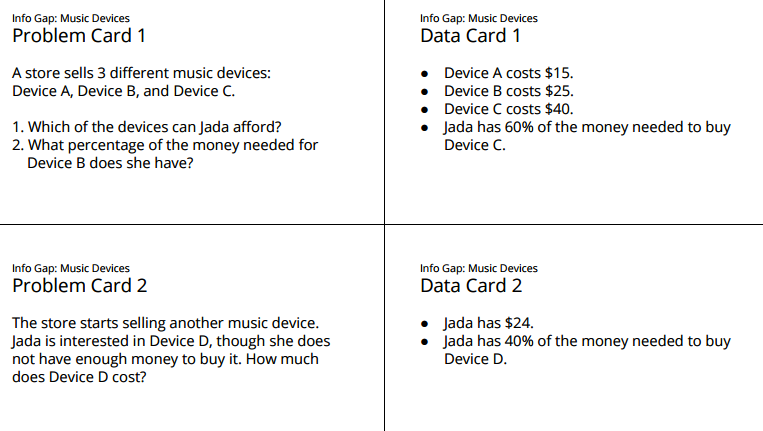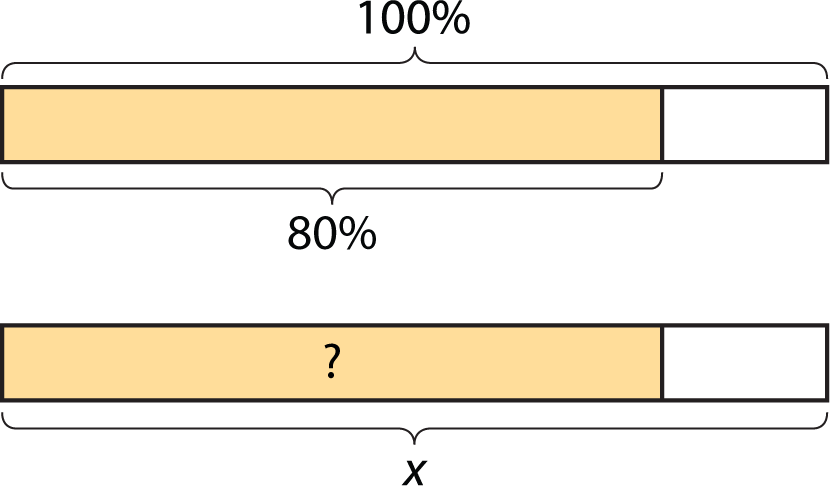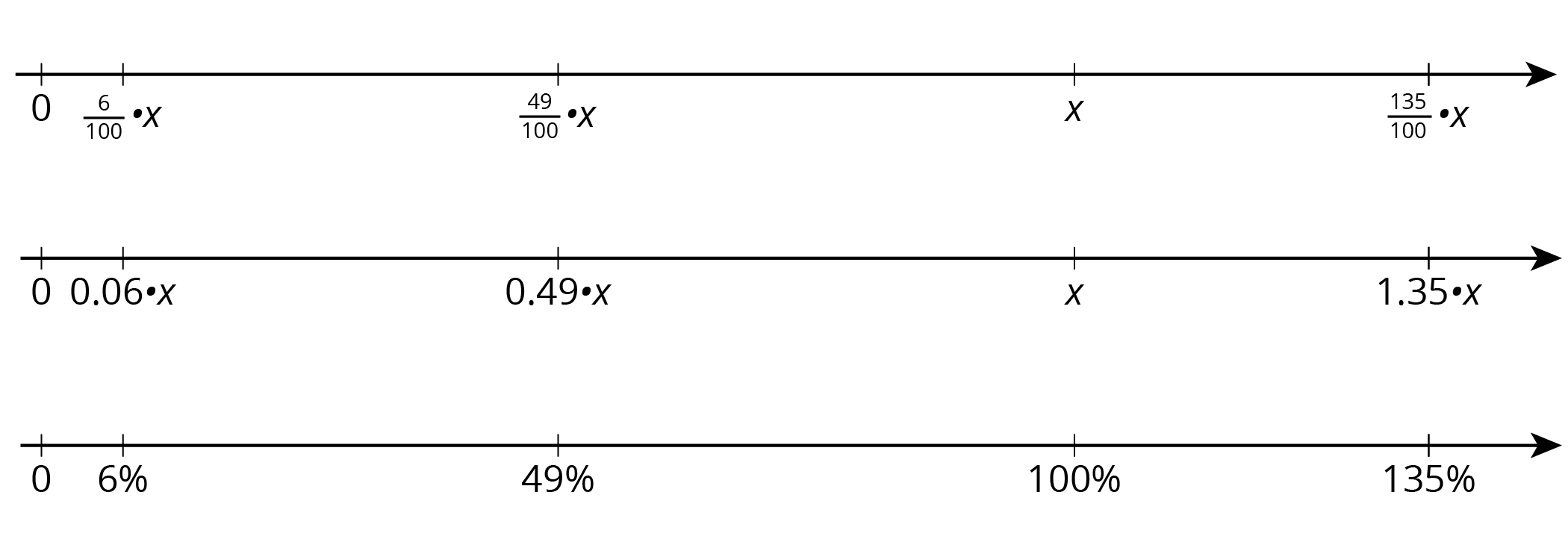Lesson 23
Solving Percentage Problems
23.1: Number Talk: Decimals (5 minutes)
Warm-up
The purpose of this number talk is to help students multiply and divide decimal numbers by 100 in preparation for their work with percentages later in the lesson.
Launch
Display one problem at a time. Give students 30 seconds of quiet think time for each problem, and ask them to give a signal when they have an answer and a strategy. Keep all previous problems displayed throughout the task.
Supports accessibility for: Memory; Organization
Student Facing
Find the value of each expression mentally.
\((0.23) \boldcdot 100\)
\(50 \div 100\)
\(145 \boldcdot \frac{1}{100}\)
\(7 \div 100\)
Student Response
For access, consult one of our IM Certified Partners.
Activity Synthesis
Select a couple of students to share their answer and strategies for each problem. Record and display their explanations for all to see. After evaluating all four expressions, ask students:
- How is multiplying by \(\frac{1}{100}\) related to division?
- What is important to remember about dividing a one digit number by 100?
To involve more students in the conversation, consider asking as the students share their ideas:
- Who can restate ___’s reasoning in a different way?
- Did anyone solve the problem the same way but would explain it differently?
- Did anyone solve the problem in a different way?
- Does anyone want to add on to _____’s strategy?
- Do you agree or disagree? Why?
Design Principle(s): Optimize output (for explanation)
23.2: Info Gap: Music Devices (20 minutes)
Activity
In this info gap activity, students find both \(A\) and \(C\) (where \(A\%\) of \(B\) is \(C\)) in the context of buying a music device. The value of \(B\) is different in each of the two questions about the music device, so students who choose to draw diagrams or tables need to draw two. When answering the second question—expressing \$24 as a percentage of \$25—students may notice that drawing a complete double number line diagram with all 25 tick marks is rather time consuming. Encourage students to look for and make use of any noticeable structure (MP7) or pattern (MP8) to help them solve more efficiently.
Some students may, for example, see that if \$25 corresponds to 100%, then each dollar—and thus each tick mark—is \(100 \div 25\) or 4. They can then bypass drawing the rest of the tick marks and simply multiply \(4 \boldcdot 24\) to obtain 96. Some may notice that \$24 is \$1 away from \$25 and simply subtract the corresponding percentage from 100% (\(100 - 4 = 96\)). A table provides another efficient structure for reasoning about this. Monitor for students who use different strategies.
The info gap structure requires students to make sense of problems by determining what information is necessary, and then to ask for information they need to solve it. This may take several rounds of discussion if their first requests do not yield the information they need (MP1). It also allows them to refine the language they use and ask increasingly more precise questions until they get the information they need (MP6).
Here is the text of the cards for reference and planning:

Note: If time is short, the second set of cards can be considered optional. It would be better for students to thoroughly understand one of these problems than to rush through both of them with less understanding.
Launch
Arrange students in groups of 2. In each group, distribute the first problem card to one student and a data card to the other student. After debriefing on the first problem, distribute the cards for the second problem, in which students switch roles.
Supports accessibility for: Memory; Organization
Design Principle(s): Cultivate Conversation
Student Facing
Your teacher will give you either a problem card or a data card. Do not show or read your card to your partner.
If your teacher gives you the problem card:
-
Silently read your card and think about what information you need to be able to answer the question.
-
Ask your partner for the specific information that you need.
-
Explain how you are using the information to solve the problem.
Continue to ask questions until you have enough information to solve the problem.
-
Share the problem card and solve the problem independently.
-
Read the data card and discuss your reasoning.
If your teacher gives you the data card:
-
Silently read your card.
-
Ask your partner “What specific information do you need?” and wait for them to ask for information.
If your partner asks for information that is not on the card, do not do the calculations for them. Tell them you don’t have that information.
-
Before sharing the information, ask “Why do you need that information?” Listen to your partner’s reasoning and ask clarifying questions.
-
Read the problem card and solve the problem independently.
-
Share the data card and discuss your reasoning.
Student Response
For access, consult one of our IM Certified Partners.
Activity Synthesis
Select students with different strategies to share their approaches to the first question, starting with less efficient methods and ending with more efficient methods. Then, ask the class to predict how the same strategies might be used to solve the second question, and how the second problem could be solved more quickly.
23.3: Everything is On Sale (15 minutes)
Activity
In general, \(P\%\) of something is \(\frac{P}{100}\) times that thing. The purpose of this activity is to make this explicit. In this activity, students are asked to find 80% of several different values, generalize their process, and express their generalization in different ways. As they make repeated calculations, students look for and express regularity in their work (MP8) and see more explicitly that \(P\%\) of a number is \(\frac{P}{100}\) times that number. Once they arrive at one or more generalizations, students practice articulating why each generalization always works (MP3).
Launch
Give students quiet think time to complete the activity and then time to share their explanation with a partner.
Supports accessibility for: Memory; Conceptual processing
Design Principles(s): Optimize output (for explanation); Maximize meta-awareness
Student Facing
During a sale, every item in a store is 80% of its regular price.
- If the regular price of a T-shirt is $10, what is its sale price?
- The regular prices of five items are shown here. Find the sale price of each item.
item 1 item 2 item 3 item 4 item 5 regular price $1 $4 $10 $55 $120 sale price -
You found 80% of many values. Was there a process you repeated over and over to find the sale prices? If so, describe it.

-
Select all of the expressions that could be used to find 80% of \(x\). Be prepared to explain your reasoning.
\(\frac{8}{100} \boldcdot x\)
\(\frac{80}{100} \boldcdot x\)
\(\frac{8}{10} \boldcdot x\)
\(\frac{4}{10} \boldcdot x\)
\(\frac85 \boldcdot x\)
\(\frac45 \boldcdot x\)
\(80 \boldcdot x\)
\(8 \boldcdot x\)
\((0.8) \boldcdot x\)
\((0.08) \boldcdot x\)
Student Response
For access, consult one of our IM Certified Partners.
Activity Synthesis
Make sure students have the correct values in the table for the second question. Then, discuss the expressions, starting with \(\displaystyle \frac{80}{100} \boldcdot x.\)
Guide students to see that if we know the value of 100%, dividing that value by 100 (or equivalently, multiplying it by \(\frac{1}{100}\)) tells us the corresponding value for 1%. We can then multiply that value by the desired percentage. Consider using a table to organize this argument, as shown below:
| percentage | regular price |
|---|---|
| 100 | \(x\) |
| 1 | \(\frac{1}{100} \boldcdot x\) |
| 80 | \(\frac{80}{100} \boldcdot x\) |
After everyone understands where this expression comes from, ask students to discuss the remaining expressions with a partner. This is a good opportunity for just-in-time review on equivalent fractions, if needed.
Lesson Synthesis
Lesson Synthesis
Tell students, “We know 20% of 400 liters is 80 liters. Knowing two values from that statement allows us to find the third. Here are three questions we can ask:
- What is 20% of a 400 liter tank? 20% of a full tank is 80 liters.
- How many liters are in the tank?
- 80 liters is what percentage of a 400 liter tank?”
Display the three questions and ask students for methods to solve each of these questions. Listen for students to mention double number lines and tables. Ask students with useful representations to share their thinking.
Additionally, in the case of the first question, or any question that involves finding \(P\%\) of \(x\), we can multiply \(\frac{P}{100} \boldcdot x\) to find the solution. Ask students how they could solve the first question, “What is 20% of a 400 liter tank?” using multiplication. (\(\frac{20}{100} \boldcdot 400 = 80\), so the solution is 80 liters.)
23.4: Cool-down - Ordering Percentages of Different Numbers (5 minutes)
Cool-Down
For access, consult one of our IM Certified Partners.
Student Lesson Summary
Student Facing
A pot holds 36 liters of water. 25% of 36 liters is 9 liters. Here are two different representations that display this information:
- A double number line:

We can divide the distance between 0 and 36 into four equal intervals to show that 9 is \(\frac{1}{4}\) of 36, or 9 is 25% of 36.
- A table:

In the case of the table, notice that the rows are multiplied by \(\frac{1}{4}\) which is equivalent to \(\frac{25}{100}\).
In general, to find \(P\%\) of \(x\), we can multiply: \(\frac{P}{100}\boldcdot x\).
- To find 49% of a number, we can multiply the number by \(\frac{49}{100}\) or 0.49.
- To find 135% of a number, we can multiply the number by \(\frac{135}{100}\) or 1.35.
- To find 6% of a number, we can multiply the number by \(\frac{6}{100}\) or 0.06.
